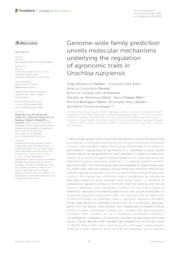Genome-wide family prediction unveils molecular mechanisms underlying the regulation of agronomic traits in Urochloa ruziziensis.
Genome-wide family prediction unveils molecular mechanisms underlying the regulation of agronomic traits in Urochloa ruziziensis.
Author(s): MARTINS, F. B.; AONO, A. H.; MORAES, A. da C. L.; FERREIRA, R. C. U.; VILELA, M. de M.; PESSOA FILHO, M. A. C. de P.; RODRIGUES-MOTTA, M.; SIMEÃO, R. M.; SOUZA, A. P. de
Summary: Tropical forage grasses, particularly those belonging to the Urochloa genus, play a crucial role in cattle production and serve as the main food source for animals in tropical and subtropical regions. The majority of these species are apomictic and tetraploid, highlighting the significance of U. ruziziensis, a sexual diploid species that can be tetraploidized for use in interspecific crosses with apomictic species. As a means to support breeding programs, our study investigates the feasibility of genome-wide family prediction in U. ruziziensis families to predict agronomic traits. Fifty half-sibling families were assessed for green matter yield, dry matter yield, regrowth capacity, leaf dry matter, and stem dry matter across different clippings established in contrasting seasons with varying available water capacity. Genotyping was performed using a genotyping-by-sequencing approach based on DNA samples from family pools. In addition to conventional genomic prediction methods, machine learning and feature selection algorithms were employed to reduce the necessary number of markers for prediction and enhance predictive accuracy across phenotypes. To explore the regulation of agronomic traits, our study evaluated the significance of selected markers for prediction using a tree-based approach, potentially linking these regions to quantitative trait loci (QTLs). In a multiomic approach, genes from the species transcriptome were mapped and correlated to those markers. A gene coexpression network was modeled with gene expression estimates from a diverse set of U. ruziziensis genotypes, enabling a comprehensive investigation of molecular mechanisms associated with these regions. The heritabilities of the evaluated traits ranged from 0.44 to 0.92. A total of 28,106 filtered SNPs were used to predict phenotypic measurements, achieving a mean predictive ability of 0.762. By employing feature selection techniques, we could reduce the dimensionality of SNP datasets, revealing potential genotype-phenotype associations. The functional annotation of genes near these markers revealed associations with auxin transport and biosynthesis of lignin, flavonol, and folic acid. Further exploration with the gene coexpression network uncovered associations with DNA metabolism, stress response, and circadian rhythm. These genes and regions represent important targets for expanding our understanding of the metabolic regulation of agronomic traits and offer valuable insights applicable to species breeding. Our work represents an innovative contribution to molecular breeding techniques for tropical forages, presenting a viable marker-assisted breeding approach and identifying target regions for future molecular studies on these agronomic traits.
Publication year: 2023
Types of publication: Journal article
Unit: Embrapa Beef Cattle
Observation
Some of Embrapa's publications are published as ePub files. To read them, use or download one of the following free software options to your computer or mobile device. Android: Google Play Books; IOS: iBooks; Windows and Linux: Calibre.
Access other publications
Access the Agricultural Research Database (BDPA) to consult Embrapa's full library collection and records.
Visit Embrapa Bookstore to purchase books and other publications sold by Embrapa.

